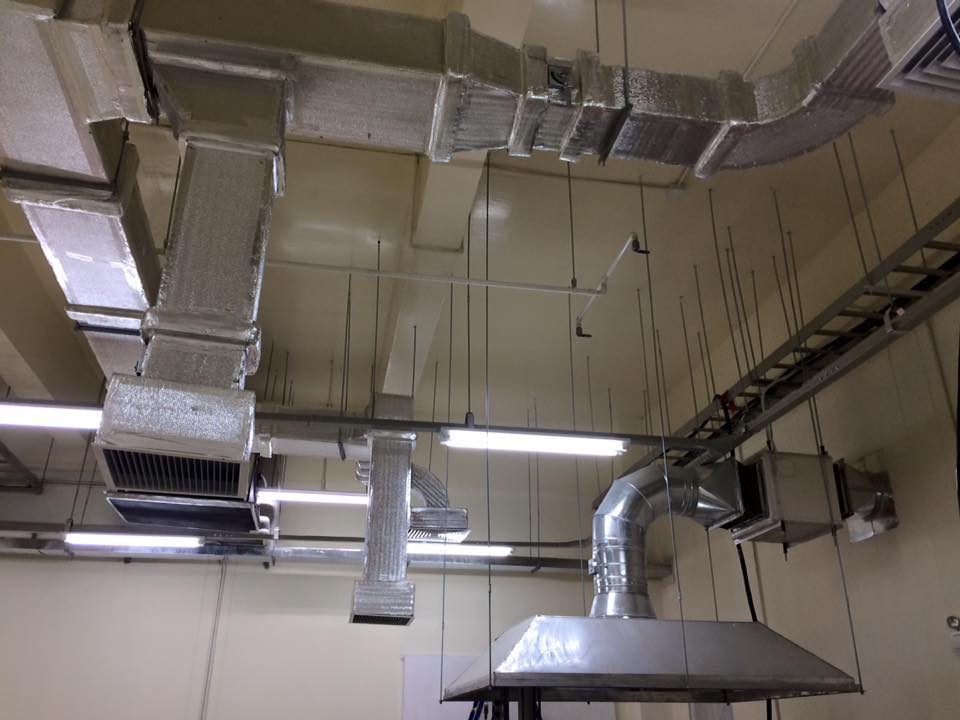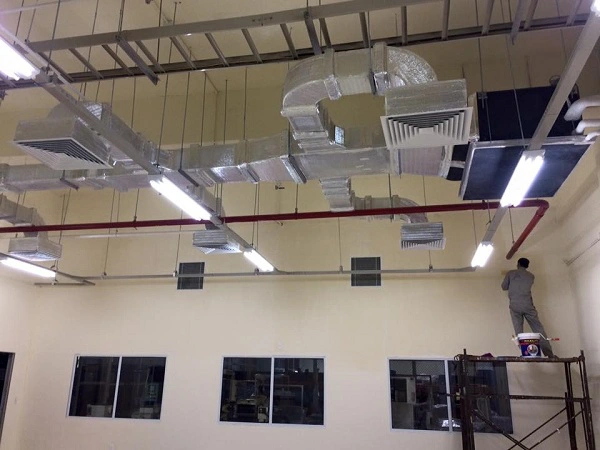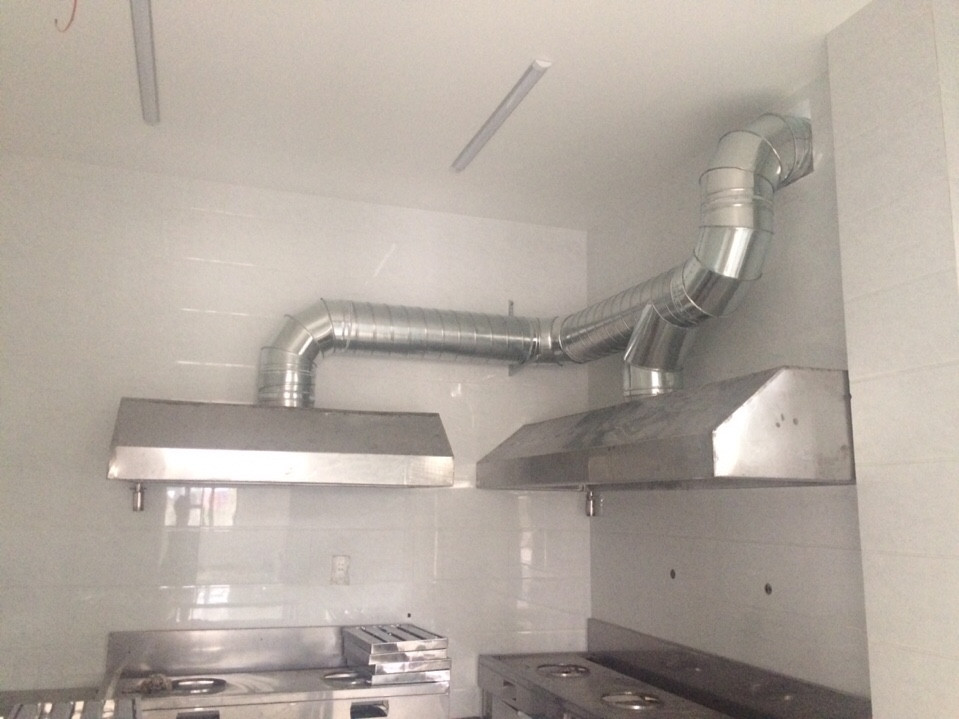The importance of exhaust ventilation in the kitchen
The reason is that in industrial kitchen spaces with continuous cooking frequency, large number of people, many dishes, many types of smoke and odors will be generated, if there is no ventilation system to supply fresh air, it will cause problems. Make the kitchen space become hot, uncomfortable, stuffy.

This will directly affect the health of staff, chefs. Affects the taste of food, the taste of food and especially can affect customers who are dining at the restaurant.
With 10 years of experience in consulting, designing and constructing many large and small kitchen projects. P69 Company would like to share its experience in designing an effective exhaust and ventilation system for an industrial kitchen space.
In fact, there are many kitchens and restaurants that are not equipped with exhaust ventilation systems or improperly designed installations. It leads to having to stop working for re-installation or repair, which takes a lot of time and has a significant impact on revenue.
What does an industrial ventilation fume extraction system include?
An industrial exhaust ventilation system includes the following equipment:

1. Smoke hood, also known as Smoke capture:
+ For family kitchens or small restaurants, this device is used to cover the upper part of the stove. The size is based on the actual surface area of the kitchen and will be measured and designed in advance.
+ For industrial kitchens of large kitchens with a large number of stoves, it will be necessary to arrange the Smoke Exhaust and Fresh Air Supply alternately to create even ventilation in the areas. Air flow in and out is monitored equally.
Ventilation design methods are usually displacement ventilation and mixed ventilation. It is important to note that when designing, it is necessary to monitor the correct flow, to avoid the fact that the smoke cannot be fully absorbed to the outside. At that time, the air from the kitchen will gradually spread to nature and the surrounding environment, not protecting the essential quality. It is also important to protect and arrange the suction cups and levels so that the chef can have the most ventilation. At the same time, also pay attention to the protruding size so that it is the most harmonious and reasonable.
2. Air duct system:
+ With a small kitchen, the hood will be attached directly from the hood to the exhaust fan. Material made from 201 stainless steel or galvanized steel. Dimensions are designed according to the practical plane.
+ For industrial kitchens of large hotel restaurants, the suction pipe uses high-grade stainless steel equipment , galvanized sheet with a minimum thickness of 1.15 mm, covered with 50 mm thick fireproof insulating glass wool, density 32 kg /m3, the fresh air supply pipe has a minimum thickness of 0.8 mm and does not need fireproof insulation.
3. Fan to supply fresh air and exhaust air:
This can be said to be the most important part to protect the air in the kitchen from circulating. The fan used to extract smoke and supply fresh air is a specialized fan, usually made of powder-coated iron, anti-rust and anti-fat. The fan motor can be placed outside and connected to the fan blade by a belt to avoid contact with hot air, or placed inside the fan, but has a grease-proof and completely heat-resistant steel case that can reach up to 180 oC..
There are 2 main lines of fresh air and exhaust fans used: Centrifugal fans and axial fans. Suction capacity is calculated in m3/h.
- The exhaust fan is calculated the suction efficiency ( Qh ) as follows: For a kitchen with its back against the wall: Qh = 0.5 xA (m3/s) + For an oasis kitchen: Qh = 0.75 xA ( m3/s )With A – Suction capture area ( square meter )
- The fresh air supply fan is calculated the supply efficiency ( Qc ) according to the suction efficiency as follows : Qc = 80 % * Qh ( m3 / s )
4. Accessories:
Depending on the design of each industrial kitchen space, there will be accessories attached such as: wind control valve, fireproof valve, box to tweak and control the exhaust fan motor, suction grease filter, lighting in the photo. suck …
Standards for installation of quality ventilation and odor extraction systems?
A kitchen hood system needs the following essential equipment:
- Fresh air supply fan, exhaust air intake.
- Scent capture
- Exhaust air duct system, fresh air pipeline.
- Air pipe fittings: one-way valve, fire stop valve.

1. Requirements for fresh air supply and exhaust fan
Selected as a special fan manufactured with materials to absorb the stove. There are two types: centrifugal fan or coaxial fan. For example, for the Kruger series of kitchen exhaust fans, the axial type has two types: TBE and TDB. The TBE fan is placed outside the motor to avoid contact with hot air, affecting the life of the motor.
The TDB fan is built with a motor inside the airflow but is encased in a special oil-resistant steel case that can withstand up to 180 degrees Celsius.
2. How should the kitchen hood be designed?
When designing the kitchen hood, it is necessary to calculate the correct flow. To avoid the situation that the flow is not fully sucked to the outside by the fan. When it is still in the kitchen air environment, it will gradually spread around, not ensuring quality.
When designing, it is necessary to ensure the arrangement of appropriate hoods and levels to ensure ventilation for the chef. At the same time, it is necessary to pay attention to the size of the suction cup that should protrude as much as possible.
3. Requirements for ductwork for smoke extraction and fresh air supply
The suction pipe uses galvanized sheet material with a minimum thickness of 1.15mm, coated with 50mm thick insulating and fireproof glass, density 32 kg/m3.
The fresh air duct uses zinc coated steel sheet with a minimum thickness of 0.8mm and does not need insulation.
4. Air pipe fittings: one-way valve, fire stop valve
Two exhaust fans should be installed, one running and one backup. Before the ejector, each exhaust fan or fresh air supply needs to be fitted with a Non-Return Valve (NCD).
Minimum suction cup height is 400mm with built-in grease filter. Placed at least 2000-2200mm from the ground and from the outside of the kitchen table, the suction cup protrudes a minimum distance of 200-300mm.
Construction and installation process of industrial kitchen exhaust system
- Conduct surveys, measurements, optimal advice for buyers.
- Prepare design drawings and cost estimates.
- Finalize the solution, manufacture and deploy the assembly design.
- Operate and check the smoke extraction capacity as well as the noise level of the fan, fresh air supply system.
- Handing over real estate projects, user manual.
- Periodic system maintenance and warranty.
Contact us today for a free consultation and answer at:
Contact information P69 – M&E . M&E Contractor
Address: No. 6/165C Xuan Thuy, Cau Giay District, Hanoi
Website: https://p69.com.vn/
Hotline: 02422121212 – 0965937799
Email: kd@cokhip69.com.vn
Facebook: https://www.facebook.com/p69nhathaucodien
LinkedIn: https://www.linkedin.com/in/congtyp69/
Youtube : https://www.youtube.com/channel/UCOUwCnE5iGj8iqe_ZIUM7oA

